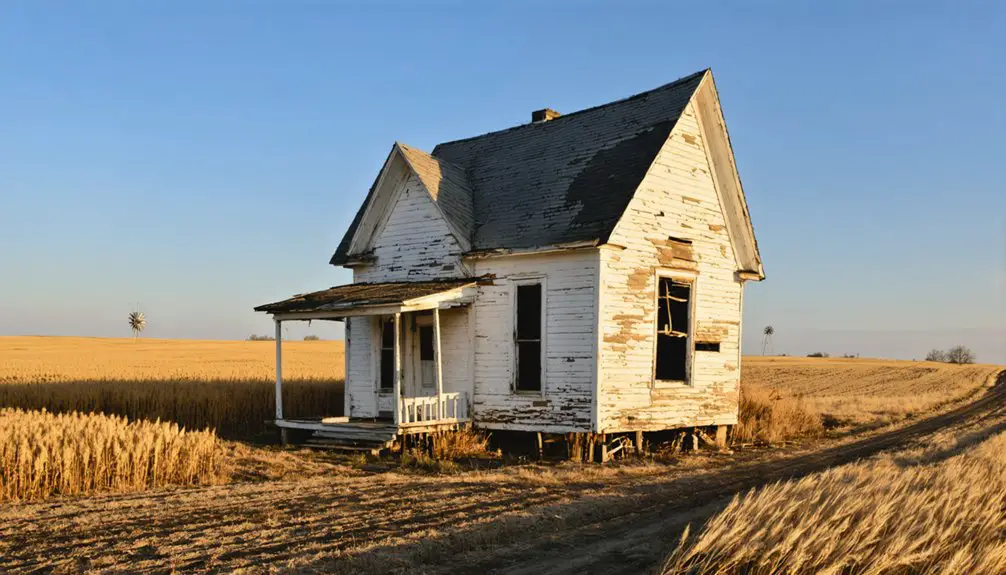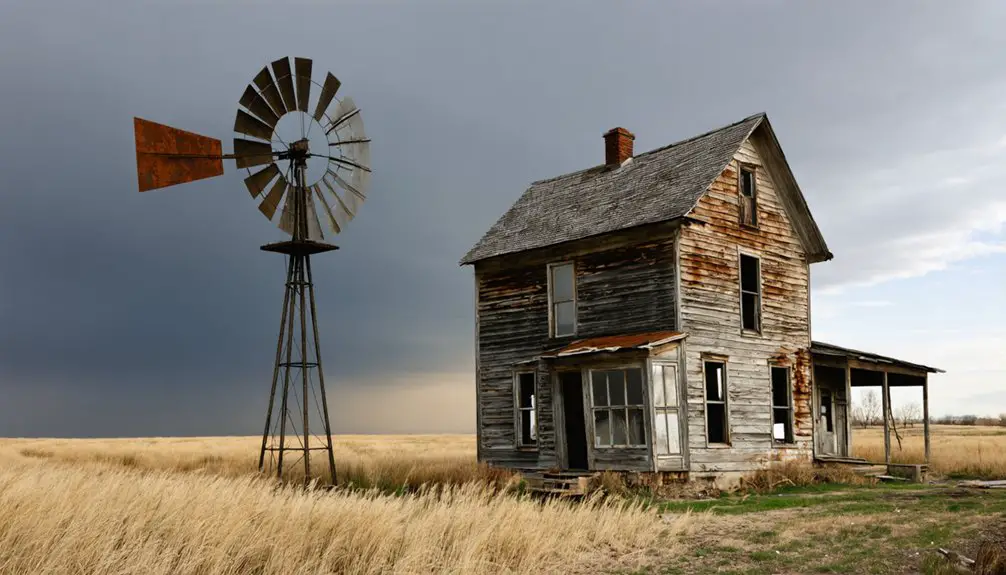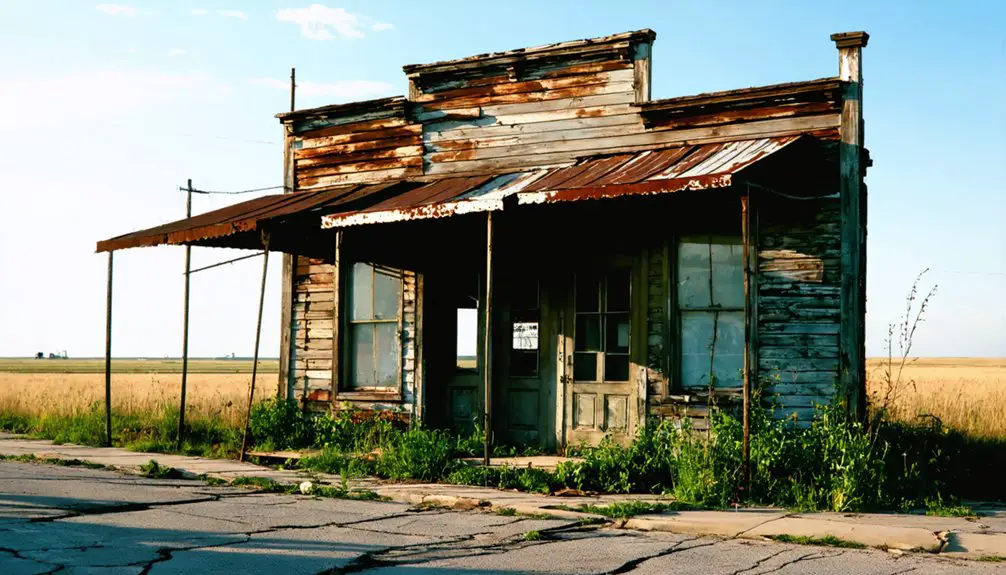You’ll find Linton’s ghost town remnants in Lancaster County, Nebraska, where pioneers settled near Salt Creek in the 1850s. The arrival of the Burlington and Missouri River Railroad in the 1880s transformed this settlement into a bustling trade hub with a post office, church, and schoolhouse. Environmental challenges, including devastating floods and agricultural decline, led to its abandonment by 1906. The story of Linton reveals how nature’s forces can reshape a community’s destiny.
Key Takeaways
- Linton was established near Salt Creek in Nebraska during the 1850s-1860s as pioneers settled the area around water sources.
- The Burlington and Missouri River Railroad’s arrival in the 1880s briefly transformed Linton into a thriving trade hub.
- Catastrophic flooding in 1908, with Salt Creek reaching 30,650 cubic feet per second, severely damaged the town’s infrastructure.
- The closure of Linton’s post office in 1906 marked the beginning of the town’s decline and eventual abandonment.
- Environmental challenges, including floods, droughts, and soil erosion, combined with economic instability to force residents to leave.
Early Settlement and Town Origins
Before European settlement transformed the landscape, the plains around Linton consisted primarily of buffalo grass, with Salt Creek serving as an essential landmark for Plains Indian tribes. The Pawnee maintained settlements along the Platte River, while Sioux nations used the area for hunting and occasional skirmishes.
When white settlers arrived in the 1850s and 1860s, they established homesteads near critical water sources and travel routes. Settlement patterns emerged as pioneers like John Cadman and the Prey family built ranches near Salt Creek crossings. Similar to the Rock Island train wreck that later shaped Nebraska’s history, these early settlements were strategically placed along transportation corridors. Like many other settlements that became ghost towns, Linton was established near a creek, which later proved problematic for the town’s survival.
These early indigenous interactions influenced where settlers chose to build, often considering both security and access to resources. As Lancaster County formed from the original Clay County territory, surveyors laid out township lines, creating the framework for Linton’s development alongside other emerging communities.
The Railroad’s Role in Linton’s Development
The arrival of the Burlington and Missouri River Railroad in the early 1880s transformed Linton from a scattered settlement into a bustling trade hub. You’d have seen railroad expansion bring unprecedented opportunities as tracks connected Linton to major markets in Omaha and Lincoln.
The railway’s presence sparked rapid economic integration, with new facilities like freight yards and stockyards making it easier to ship agricultural products and receive essential supplies. The railroad company offered generous land grants to attract settlers and development to the area. Similar to North Platte, Linton became one of several small villages that developed along transportation routes.
As trains rolled through town, you’d have witnessed Linton’s growth accelerate. The railroad attracted immigrant settlers, created jobs, and established crucial transportation links.
Burlington’s influence even shaped local farming practices, encouraging the cultivation of alfalfa as a commercial crop. Railroad technology brought modern amenities, while maintenance shops and depots made Linton an important stop along Nebraska’s expanding rail network.
Daily Life in Late 19th Century Linton
While the railroad brought sweeping changes to Linton’s physical landscape, daily life in this small Nebraska community remained deeply rooted in agricultural rhythms and close-knit social bonds.
You’d find community dynamics centered around the local schoolhouse and church, where residents gathered for everything from barn dances to communal meals. The seasonal rhythms of planting and harvest dictated work patterns, with families helping each other through these demanding periods. Local farmers would transport their harvests to the grain elevator that stood prominently along the Lincoln Highway.
Inside modest wooden homes, you’d see women preserving food, managing households without modern conveniences, and relying on wood stoves for heat. Some families opted to build sod house dwellings, which provided superior insulation against harsh weather. Children learned together in one-room schoolhouses, while everyone depended on home remedies and traveling doctors for medical care.
Daily chores and survival skills shaped frontier life, as families preserved food, heated homes, and relied on simple medical care.
Despite the challenges of frontier isolation, Linton’s residents forged strong connections through mutual aid and shared experiences.
Natural Disasters and Environmental Challenges
You’ll find that Salt Creek’s recurring floods played a decisive role in Linton’s fate, with severe flooding eventually forcing the closure of the post office in 1906.
Much like the potash ruins of Antioch, the structural remains of Linton deteriorated rapidly due to exposure to harsh environmental conditions.
The economic instability of the Financial Panic in 1857 further strained the struggling town’s resources and development.
The area’s unpredictable weather patterns brought additional hardships to the community, including harsh winters and destructive storms that disrupted daily life.
The combined effects of flooding and adverse weather conditions gradually degraded the agricultural land, making it increasingly difficult for farmers to maintain viable crops and sustain the town’s economy.
Salt Creek Flood Impact
Since its early days, Linton faced devastating challenges from Salt Creek’s flood patterns, most importantly during the catastrophic 1908 flood when nearly seven inches of rain transformed the creek into raging torrents with peak discharges of 30,650 cubic feet per second.
Like many settlements in the Salt Creek basin, Linton’s location in the floodplain made it particularly vulnerable to these destructive waters. The community’s flood preparedness was limited by the era’s lack of modern infrastructure, which wouldn’t arrive until the U.S. Army Corps of Engineers later built dams and levee systems. A more recent flood in May 2015 demonstrated the effectiveness of these improvements when Salt Creek projects successfully mitigated flooding damages in central Lincoln.
Despite efforts to build community resilience, the recurring floods damaged foundations, forced evacuations, and disrupted local economies. These environmental challenges, combined with the region’s wetland conditions, ultimately contributed to Linton’s eventual decline.
Weather Pattern Disruptions
In addition to flooding from Salt Creek, Linton faced a barrage of severe weather challenges typical of Nebraska’s volatile climate patterns.
You’ll find that the town battled against nature’s extremes, from devastating tornadoes during late spring to intense summer heat waves reaching above 90°F. The settlement’s location in Tornado Alley meant residents endured 50-70 twisters annually across the region, often accompanied by destructive hail and fierce winds exceeding 50 mph.
The area’s climate variability brought brutal winter temperatures below 0°F, while recurring droughts and dust storms battered the community’s resilience. Historical records show winter conditions were particularly harsh, with average January lows of 13.5°F tormenting residents.
These weather extremes triggered significant vegetation changes, weakening the soil’s stability and creating a harsh cycle of environmental challenges. For a small town like Linton, these relentless natural forces proved extraordinarily difficult to overcome.
Agricultural Land Degradation
While Linton’s farming community initially thrived on the region’s rich prairie soils, a perfect storm of environmental challenges gradually devastated their agricultural foundation.
You’ll find that over-plowing combined with recurring droughts left the once-fertile land cracked and eroded. The harsh Plains winds swept away precious topsoil, while natural creek flooding altered soil composition in ways that hurt crop viability.
The community’s agricultural practices couldn’t withstand the relentless assault of Hessian fly infestations destroying wheat crops and water scarcity limiting irrigation options.
As farmers abandoned their fields, soil conservation efforts ceased, creating a destructive cycle. Without proper land management and communal maintenance, the degraded soil couldn’t support sustainable farming.
These compounding factors transformed productive farmland into barren terrain, ultimately contributing to Linton’s decline into a ghost town.
The Post Office Era: 1889-1906
You’ll find the story of Linton’s post office deeply woven into the fabric of this prairie community, where from 1889 to 1906 it served as both a mail hub and gathering place for local residents.
The facility played a crucial role in connecting homesteaders to the outside world through letters, newspapers, and government notices during Nebraska’s transformative railroad era.
The post office’s closure in 1906 marked a turning point for Linton, reflecting the broader pattern of rural postal consolidation that affected many small Nebraska towns of the period.
Early Mail Service Operations
During the pioneering days of Linton, the local post office served as an essential federal presence from 1889 to 1906, connecting residents to the outside world through an evolving mail system.
You’d find the postmaster, often a prominent local figure, managing daily operations from a dedicated postal infrastructure that included patented collection boxes with separate slots for letters and newspapers.
Mail delivery relied on a combination of transportation methods – trains carried mail long distances via Union Pacific rails, while local carriers used horses and wagons to reach residents.
If you didn’t have a fixed address, you could collect your mail through general delivery at the post office window.
The system worked efficiently thanks to postal regulations that encouraged direct delivery, while postmasters maintained financial oversight of all operations.
Community Hub Role
As the heart of community life in Linton, the post office transcended its basic mail-handling duties to become an essential hub of social and economic activity from 1889 to 1906.
You’d find residents gathering there daily, exchanging news and strengthening social networks while conducting their postal business. The facility’s impact extended beyond mail service, attracting general stores and boosting local commerce through enhanced communication about market prices and trade opportunities.
The postmaster, a trusted community leader, didn’t just handle mail – they facilitated money orders, government announcements, and unofficial news sharing.
You’ll appreciate how the post office influenced the town’s development, raising nearby property values and creating both direct and indirect employment opportunities.
It’s where you’d witness the pulse of frontier life, as settlers forged connections that shaped Linton’s identity.
Final Days and Closure
While Linton’s post office had served as an essential communication hub since 1889, the town’s declining population and shifting economic landscape led to its closure in 1906.
You’d have witnessed the gradual exodus of residents to nearby railroad towns that offered better opportunities and stronger transportation links. As businesses shuttered and commerce dwindled, postal service activity naturally decreased, reflecting the community’s diminishing vibrancy.
The loss of this critical community connection accelerated Linton’s transformation into a ghost town.
When the post office closed its doors, you’d have seen the remaining residents face increased isolation from neighboring communities. The building that once buzzed with daily activity stood as a silent reminder of the town’s fading significance in an era when railroad access determined a settlement’s fate.
Factors Leading to Abandonment
Since the early 1900s, multiple interconnected factors contributed to Linton’s transformation from a viable settlement into a ghost town. Demographic shifts and economic decline accelerated after the closure of Linton’s post office in 1906, signaling the beginning of the town’s deterioration.
Linton’s descent into abandonment began in 1906 with its post office closure, marking a turning point in the settlement’s decline.
You’ll find that larger urban centers like Lincoln drew residents away with promises of better opportunities and modern amenities.
- The town’s isolation from major transportation routes limited access to essential goods and services.
- Competition from neighboring settlements with railroad connections diminished Linton’s economic viability.
- Young residents left for education and employment in urban areas, leading to an aging population and reduced community vibrancy.
These challenges, combined with inadequate infrastructure development, made it increasingly difficult for Linton to sustain itself as a viable community.
Legacy and Historical Significance

Though Linton itself has vanished from the landscape, its legacy endures as a significant piece of Lancaster County‘s settlement history. You’ll find its influence woven into the broader cultural heritage of Nebraska’s pioneering era, particularly through its position near important Indian trails that shaped early transportation routes.
Like other ghost towns in the region, Linton played an essential role in the community dynamics that defined Nebraska’s development during the 1860s.
You can trace its impact through surviving cemeteries and scattered remnants that connect modern Lancaster County to its agricultural roots. The town’s story reflects the larger patterns of settlement, political formation, and rural development that transformed Nebraska from frontier territory to established state, contributing to the foundation of what would become the greater Lincoln area.
Frequently Asked Questions
Were There Any Notable Crimes or Lawlessness Reported in Linton?
You’ll find limited crime incidents documented, with one major 1900 homicide at Whitman Hotel where a husband killed his wife. Beyond that, law enforcement records show minimal criminal activity.
What Type of Businesses and Shops Operated in Linton at Its Peak?
You’d find essential businesses like a general store stocking dry goods and supplies, plus a blacksmith shop serving local farmers’ equipment needs and travelers passing through the community.
Did Any Famous or Historically Significant People Come From Linton?
You won’t find any famous residents or historically significant figures from this community. Historical records don’t document any notable individuals emerging from Linton before its decline and eventual abandonment in 1906.
What Happened to the Residents After They Left Linton?
You’ll find Linton’s legacy lived on as residents migrated to Lincoln and nearby towns, taking industrial jobs, railroad work, or urban services while maintaining family connections through community events and shared heritage activities.
Were There Any Schools or Churches Established in Linton?
While many frontier towns had 1-2 religious or educational buildings, you won’t find evidence of formal schools or churches in Linton. Historical records don’t mention any established Linton education or religious institutions.
References
- https://llcgs.info/cpage.php?pt=54
- https://history.nebraska.gov/wp-content/uploads/2017/12/doc_publications_NH1937GhostTowns.pdf
- https://nebraskarules.tripod.com/id11.html
- https://history.nebraska.gov/ghost-abound-in-nebraska-towns/
- https://visitnebraska.com/trip-idea/explore-7-authentic-ghost-towns-nebraska
- https://www.youtube.com/watch?v=a1MfWA6kCIc
- https://www.americanheritage.com/ghost-town-river
- https://en.wikipedia.org/wiki/History_of_Lincoln
- https://llcgs.info/cpage.php?pt=51
- https://www.johndclare.net/AW15_Platte.htm



